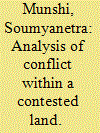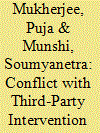| Srl | Item |
| 1 |
ID:
120396


|
|
|
|
|
| Publication |
2013.
|
| Summary/Abstract |
This paper considers the case of Kashmir to examine the relation between the people of the contested land (Indian-occupied Kashmir) and one of the nation states claiming it (India, in this case) in a game-theoretic framework. The motivation for this paper was whether it was possible to rationalize the lack of democratic space in Kashmir, relative to other states in India (especially since the founding fathers of the country had announced such democratic practices to be the guiding principles of the new nation) and at the same time, a highly rigid stance of the Indian Government on the Kashmir issue. An otherwise standard political economic model is used to capture how the way in which citizens determine their allegiance to one or the other nation state (India or Pakistan) can, in turn, affect the nation state's (India's) policies towards the contested land. I conclude that if the Indian Government perceives allegiance of the citizens to be determined primarily by partisan preferences of the citizens, not so much by their preferences for policies, then the government rationally concentrates on minimizing its disutility due to deviations from its 'most-favorite' policy. This understanding rationalizes the policies of the Indian Government towards Kashmir. More importantly, it points towards areas that need consideration for any peace-making process to take-off.
|
|
|
|
|
|
|
|
|
|
|
|
|
|
|
|
| 2 |
ID:
192048


|
|
|
|
|
| Summary/Abstract |
Most real-world conflicts are characterised by the presence of third-party interventions as well as prolonged and revengeful violent interactions between the conflicting parties. However, most of the conflict literature studies the impact of each of these forces – third-party intervention and revenge motivations – on the conflict, in isolation from each other. This paper attempts to fill in this gap and aims to explore the impact of these two forces acting in conjunction with each other on a conflict situation. In fact, we also endogenise the intervention decision of the third party and explore parametric restrictions under which a third party decides to intervene (either as an ally of one of the conflicting parties or as an ‘idealist’ aiming to reduce overall conflict levels) and its repercussions on associated conflict levels. We also present narrative evidences of some real-life conflicts that amply exhibit the two forces of third-party intervention and revenge.
Peace is the only battle worth waging. – Albert Camus
|
|
|
|
|
|
|
|
|
|
|
|
|
|
|
|
| 3 |
ID:
165349


|
|
|
|
|
| Summary/Abstract |
This paper proposes a simple game-theoretic framework for analyzing the relationship between the government, industry and indigenous community, especially in the context of mounting violence surrounding displacement of indigenous communities by governments for the purposes of commercial use of their habitat. It specifically takes into account the possibility of alleged ‘nexus’ between the government and the industry and explores its implications on the level of allocation and utilities of the players. We find that the bias in allocation that occurs when the government and the industry enter a ‘nexus’ can be rectified when there is resistance from the indigenous groups. Moreover, rebellion is a dominant strategy of the indigenous community, irrespective of whether there is ‘nexus’ or not, and being in ‘nexus’ with the government is a best response for the industry. The unique SPNE occurs when there is ‘nexus’ between the industry and the government and resistance by the indigenous groups, corroborating the widespread allegations of ‘nexus’ and evidence of resistance worldwide. We also explore a few extensions of the basic model and present some narrative evidence in support of the theoretical model.
|
|
|
|
|
|
|
|
|
|
|
|
|
|
|
|